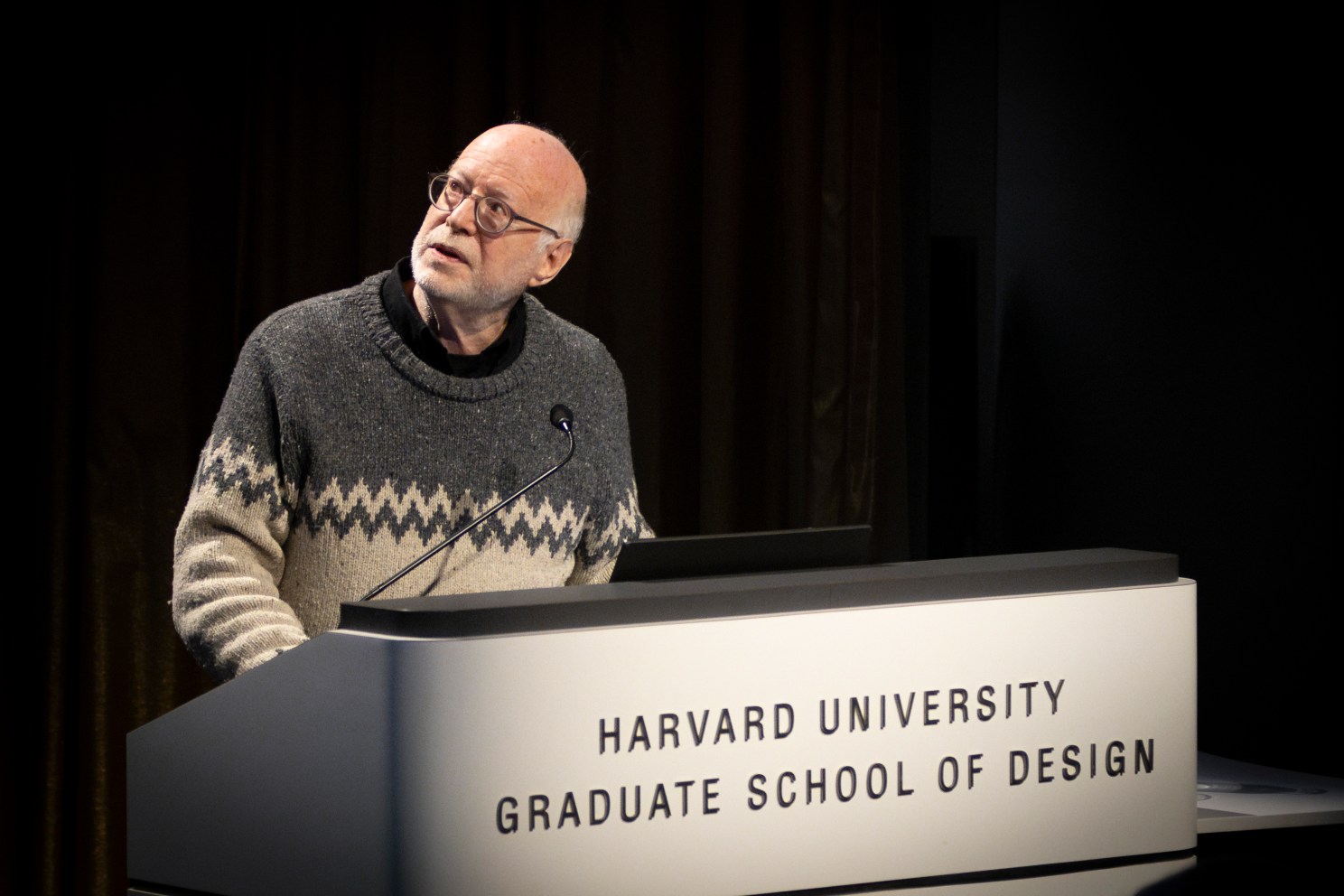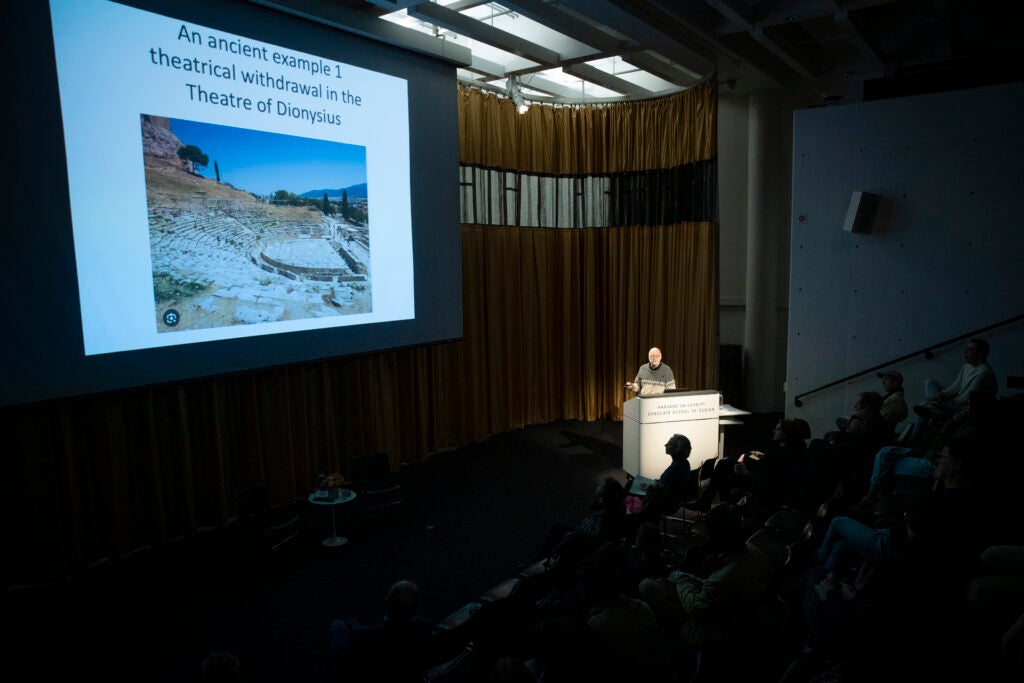
Richard Sennett (pictured) speaking during the event. Photos of the event, ‘Richard Sennett, “Stages and Streets: Where Performances Happen and Why They Happen Where They Happen’” in the Harvard Graduate School of Design’s Piper Auditorium in Gund Hall. Niles Singer/Harvard Staff Photographer
Photos by Niles Singer/Harvard Staff Photographer
All the world’s a stage
Richard Sennett urges revitalizing public life, spaces, politics by creating spaces that engage imagination
Richard Sennett began his career as a professional cellist and became a well-known sociologist whose work looks at urban design, public culture and art, and how life in cities affects individuals and the ties between them. And now in a new book, he looks to bring it all together.
“My life as a performing musician never really left me during the decades that I’ve been doing sociology. And in this book, I try and bring these two realms together,” he said of the soon-to-be released “The Performer: Art, Life, Politics.”
Sennett — who also authored “The Fall of Public Man,” “Flesh and Stone,” “The Corrosion of Character,” and “The Craftsman” — spoke about his new work at an event hosted by the Harvard Graduate School of Design on April 3. He focused his talk on the power of theater to revitalize public life and even politics.
The moment a public space transforms into theater is when it becomes “a realm in which people can diverge from the ordinary, from routine,” he explained. But there are better and worse ways to do it.
Take Faneuil Hall or Times Square. These are examples of “tourist-orientated theater,” in which the spectacle of performance might draw people into the marketplace. For a day or two this might be wonderful. But for those who live in the area, it quickly becomes a place to avoid. “Native New Yorkers [avoid] this theatrical space like the plague,” he said.

Sennett said he thought New York had greater success in looking at the natural world in theatrical terms, pointing to Central Park “where by putting the cars below ground level … the city has disappeared.”
Sennett is the winner of multiple global awards, including the Hegel Prize, the Spinoza Prize, an honorary doctorate from Cambridge University, and the centennial medal from Harvard University in 2017. He also serves as a member of the United Nations Committee on Urban Initiatives, having advised on urban issues for 30 years.
During the talk, he took the audience through the evolution of public performance spaces, from ancient Athens to Shakespeare’s Globe Theatre in London. Earlier spaces, he said, were open and in nature and over time became more defined.
The Globe was a structure but still open-air. There were no sets or backdrops and performances required a particularly active imaginative collaboration with the audience. This was in the late medieval-early Renaissance.
In the same period came the break between “stage and street,” Sennett said. He pointed to the Teatro Olimpico in Vicenza, Italy, as an example and joked that all the attendees should be gifted plane tickets to see it themselves. He highlighted the wood-and-stucco set imitating an ornate marble wall with openings revealing realistic trompe-l’œil scenes of the city.
“They show an idealized view of the city, perfectly clean, orderly … You look into a space that’s beautiful, but unreal,” he said. The backdrop remains the same regardless of whether the performance is comedy or tragedy. “You get this divorce between what’s happening in the realm of art and what’s happening as it were looking out into the city.”
Richard Sennett, about Teatro Olimpico in Italy
“They show an idealized view of the city, perfectly clean, orderly … You look into a space that’s beautiful, but unreal.”
Sennett characterized this separation between audience, theater, and world as an illustration of the modern “tension between a street space and the spaces of imagination.” And he asked: “How can we make a more porous relationship between the actual life of the streets and what goes on inside the theater?”
One solution Sennett pointed to was based on the work of Steve Tompkins, who designed the Young Vic theater in London in 1970. (Tompkins is also set to design Harvard’s new theater in Allston.) In this instance, the theater was designed to incorporate the street itself into the space, including a café. That had never been done before, and the idea that people could drink and eat while a performance was happening was innovative at the time.
The idea of porous relationships can also be applied to theater and politics, Sennett said. Take Martin Luther King Jr.’s March on Washington for Jobs and Freedom. The main organizer of the protest was Bayard Rustin, an accomplished singer with a performance background.
The goal of the massive outdoor gathering at the Lincoln Memorial, where King delivered his “I Have a Dream” speech, was to create “a magical space that … reimagines the street.” There were “lots of spaces where people come enter from the sides, like coming from the wings onto a central stage.” Participants were handed signs that Sennott likened to “masks … that anybody can wear.”
The result was one of the “great pieces of political theater in that sense organized in order to give a sense that we’re allone,” Sennett said.
Political discourse is in many ways exhausted, he said, and as a society we need new ways of thinking to bring people together. Reimagining spaces is one way designers can bring their skills to the table.
“That’s the politics that we can build,” he said.




